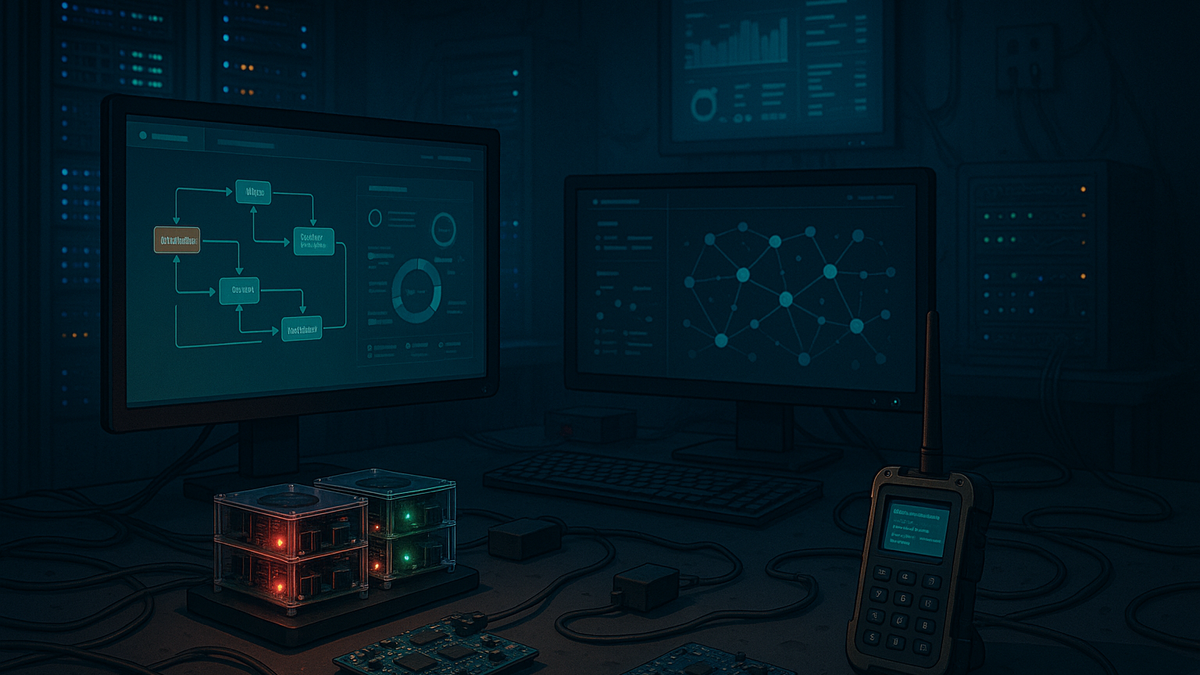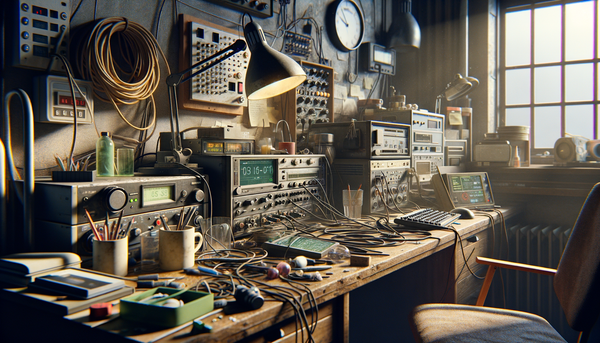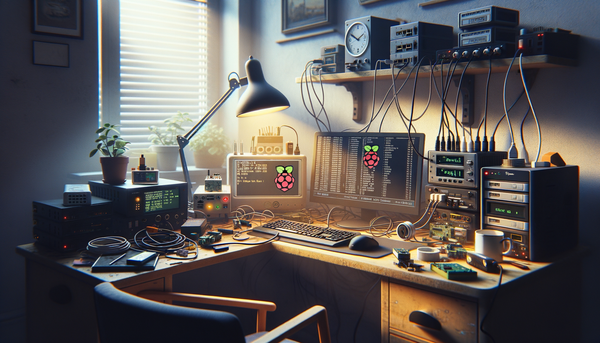The Ultimate Home Lab Hardware Guide: Components, Costs, and Best Practices
Discover the ultimate home lab hardware guide covering CPU choices, RAM sizing, storage options, networking gear, power efficiency, and budgeting for 2025. Build your perfect lab!

Key Takeaways
- Home labs are versatile platforms for learning, testing, and hosting personal services.
- CPU choice depends on workload balance between core count and clock speed.
- Memory sizing, especially ECC RAM, is critical for virtualization and storage reliability.
- Storage options include SATA SSD, NVMe SSD, and HDD, each suited for different needs.
- Networking hardware like managed switches and robust routers enable efficient traffic management.
- Power efficiency and noise reduction enhance usability and reduce operational costs.
- Careful chassis and rack selection impact cooling, expansion, and noise.
- Upgrading and maintenance ensure longevity and performance of your home lab.
- Budgeting should consider upfront and recurring costs, balanced with future expandability.
Table of Contents
- Introduction
- CPU Selection
- Memory Considerations
- Motherboard Choice
- Storage Options
- DIY NAS Build
- Networking Hardware
- Budget & Hardware Sourcing
- Power Efficiency & Noise
- Chassis & Rack Infrastructure
- Maintenance, Upgrades & Checklist
- Cost Analysis
- Conclusion
- Frequently Asked Questions
Introduction
A home lab hardware guide is the essential blueprint for anyone looking to build or upgrade a personal lab environment. Whether you're a tech enthusiast, IT professional, or someone looking to learn new skills, this comprehensive resource outlines every component choice, cost consideration, and best practice you'll need to make informed decisions.
Home labs serve multiple purposes - from learning environments and testing platforms to hosting personal services and media servers. The hardware you select will directly impact what you can accomplish, how much you'll spend upfront and over time, and even where you can physically place your lab.
This guide addresses the most common questions about home lab hardware - from component selection and direct comparisons to budgeting, power efficiency, and noise control. We'll walk through everything you need to know about CPUs, memory, motherboards, storage options, networking gear, chassis selection, and more.
By the end of this home lab hardware guide, you'll have a complete home lab hardware checklist and understand the true cost of home lab hardware to help you build exactly what you need.
CPU Selection
Your CPU choice forms the foundation of your lab's capabilities, especially for virtualization and container workloads that are common in home labs.
Best CPU for Home Lab Server
Intel Xeon:
- Proven reliability in enterprise environments
- Broad hypervisor and OS compatibility
- Abundant second-hand availability, especially in Dell PowerEdge R640/R740 systems
- Better for labs with legacy software requirements
Read more
AMD EPYC:
- Superior performance-per-watt for multithreaded tasks
- Higher core counts at similar price points
- Excellent for virtualization hosts
- Less used-market supply and potentially higher upfront cost
Read more
Consumer CPUs (Intel Core/AMD Ryzen):
- Lower power draw and operational cost
- Sufficient for small to mid-sized labs
- Modern versions often include virtualization extensions
- More compact form factors available
Read more
Home Lab CPU Cores vs Speed
When selecting a CPU, you'll need to balance core count against clock speed based on your workloads:
Core Count:
- Determines how many VMs or containers you can run simultaneously
- More cores = better parallel processing capability
- Start with 4-8 cores for beginners
- Scale to 16+ cores for heavy virtualization environments
Clock Speed:
- Impacts single-threaded application performance
- Higher clock speeds benefit game servers, web servers, and single-threaded services
- Look for at least 2.5GHz base clock for general use
For most home labs, prioritize core count if you'll run many services simultaneously. If you're hosting just a few demanding applications, favor higher clock speeds.
Read more
Power Considerations
For a power efficient home lab hardware setup, consider:
- TDP (Thermal Design Power) ratings - lower is better for energy efficiency
- Newer CPU architectures generally offer better performance per watt
- Choose low power home lab server components where possible
- Calculate ongoing electricity costs when comparing options
- Consider AMD options, which often provide better efficiency
Memory Considerations
Memory is often the limiting factor in home labs, particularly for virtualization.
How Much RAM for Home Lab
Sizing Guidelines:
- Light usage (few VMs or basic NAS): 16-32GB
- Moderate virtualization (several VMs/containers): 64GB
- Heavy enterprise-style workloads: 128GB+
Always build in headroom for future expansion and to reduce swap file reliance, which can severely impact performance.
Read more
Read more
ECC Memory for Home Lab
Error-Correcting Code (ECC) memory detects and corrects single-bit memory errors, providing additional reliability:
Benefits:
- Prevents silent data corruption
- Critical for 24/7 operation and storage-centric applications
- Provides peace of mind for mission-critical workloads
Considerations:
- Requires compatible motherboards and CPUs
- Costs 10-20% more than non-ECC
- Strongly recommended for DIY NAS setups and servers handling important data
- Optional for labs focused on learning and testing
When upgrading home lab hardware, memory is often the most cost-effective enhancement for improving overall system performance.
Read more
Motherboard Choice
Your motherboard selection determines CPU compatibility, expansion options, and remote management capabilities.
Choosing Home Lab Motherboard
Key Factors:
- CPU socket compatibility (Intel vs AMD, generation)
- Number of RAM slots and maximum supported memory
- ECC memory support (if required)
- PCIe expansion slots for NICs, HBAs, GPUs
- SATA port count and NVMe slots
- Form factor (ATX, micro-ATX, mini-ITX, server-specific)
Remote Management:
- IPMI (Intelligent Platform Management Interface) on Supermicro and some ASUS boards
- iLO (Integrated Lights-Out) on HPE servers
- iDRAC on Dell PowerEdge servers
- Enables headless control, remote power, virtual media mounting
Server-grade motherboards typically offer better reliability and remote management but cost more than consumer options. Choose based on your expansion needs and reliability requirements.
Read more
Storage Options
Storage performance directly impacts VM responsiveness, database speed, and overall system usability.
Home Lab Storage Options
SATA SSD:
- Speed: 500-2000 MB/s
- Cost-effective for OS and light VM workloads
- Good balance of price, performance, and reliability
- Ideal for boot drives and moderate workloads
NVMe SSD:
- Speed: 3000-7000 MB/s
- Optimal for high-IOPS workloads
- Perfect for virtualization hosts and database servers
- Effective as caching tier
HDD (Hard Disk Drive):
- Speed: 5400-7200 RPM (100-200 MB/s)
- Best value for bulk storage
- Ideal for backups, media libraries, and archival needs
- Higher capacity per dollar than SSDs
SSD for Home Lab vs NVMe for Home Lab
When choosing between SATA SSDs and NVMe drives, consider:
Throughput:
- NVMe: Up to 7000 MB/s (PCIe 4.0)
- SATA SSD: Limited to ~550 MB/s
Latency:
- NVMe: Generally under 0.1ms
- SATA SSD: Typically 0.2-0.5ms
Endurance:
- Look for TBW (Terabytes Written) ratings
- Higher-end drives offer better endurance for write-heavy workloads
Recommendations:
- Use NVMe for databases, virtualization, and high-concurrency workloads
- Choose SATA SSDs for budget builds or lower-demand applications
- Consider a tiered approach: NVMe for working data, SATA SSD for less-accessed data
HDD for Home Lab NAS
For bulk storage, especially in a NAS (Network Attached Storage) setup:
- Choose NAS-rated drives (WD Red, Seagate IronWolf) for 24/7 operation
- Consider CMR (Conventional Magnetic Recording) over SMR (Shingled) for better performance
- Larger drives (8TB+) often offer better value per terabyte
- Include enough redundancy to protect against drive failures
Home Lab RAID Setup
RAID (Redundant Array of Independent Disks) provides data protection and/or performance improvements:
RAID 1 (Mirroring):
- 50% storage efficiency (two 4TB drives yield 4TB usable)
- Simple redundancy - data is written to two drives
- Good for boot drives and critical data
RAID 5 (Striping with Parity):
- Good capacity vs redundancy balance
- Requires minimum of 3 drives
- One drive can fail without data loss
- Write performance penalty due to parity calculations
RAID 6 (Dual Parity):
- Tolerates two simultaneous drive failures
- Lower write speeds than RAID 5
- Minimum 4 drives required
- Best for larger arrays (6+ drives)
RAID 10 (Mirrored Stripes):
- Best performance with good redundancy
- Requires minimum 4 drives
- 50% storage efficiency
- Can withstand multiple failures in some cases
The best RAID for home lab depends on your priorities - RAID 1 or 10 for simplicity and reliability; RAID 5/6 for larger arrays where maximizing usable space matters.
Read more
DIY NAS Build
Building your own NAS gives you complete control over hardware selection and configuration:
DIY NAS Build Guide
-
Select Chassis:
- Choose a case with hot-swap bays or ample 3.5" drive mounts
- Consider airflow for drive cooling
- Tower or rackmount based on your space constraints
-
Choose Motherboard:
- Look for ECC memory support
- Ensure adequate SATA ports or expansion options
- Consider built-in RAID capabilities
-
Install Memory and Power Supply:
- Use ECC RAM for better data protection
- Select an efficient PSU (80 PLUS Gold/Platinum)
- Size PSU based on drive count and potential expansion
-
Configure Storage:
- Mix SSD/NVMe for OS and cache
- HDDs for bulk storage tier
- Consider RAID or software-based data protection
-
Set Up Storage Controller:
- Use onboard SATA, HBA card, or dedicated RAID controller
- For ZFS, consider LSI HBAs in IT mode for direct disk access
-
Install NAS OS:
- TrueNAS Core/Scale: ZFS-based, highly reliable
- unRAID: Flexible array management, good for mixed drive sizes
- Proxmox: Combines VM platform with storage capabilities
-
Secure Network Configuration:
- Assign static IP address
- Configure SMB/NFS shares
- Set up proper user permissions and authentication
-
Backup Strategy:
- Configure scheduled snapshots
- Plan offsite or cloud backup for critical data
Read more
Networking Hardware
Networking is the backbone of any lab, connecting your servers, storage, and services:
Home Lab Networking Hardware
Basic Topology:
- Internet → Router → Managed Switch → Servers
- Consider segregating lab traffic from home network
Required Components:
- Router/firewall
- Managed switch
- Patch panel (optional but recommended)
- Quality Ethernet cables (Cat5e minimum, Cat6 or better preferred)
Managed Switch for Home Lab
A managed switch enables advanced networking configurations:
Key Features:
- VLAN segmentation for separating traffic types
- Link aggregation for bandwidth improvement
- Port monitoring for troubleshooting
- QoS (Quality of Service) for prioritizing critical traffic
Layer 2 vs. Layer 3:
- Layer 2: VLAN and basic management capabilities
- Layer 3: Adds routing between networks without a separate router
PoE (Power over Ethernet):
- Powers devices like access points and IP cameras over network cable
- Available in different power classes (PoE, PoE+, PoE++)
- More expensive but eliminates separate power adapters
Port Count:
- 8-port for small labs
- 16 or 24-port for medium setups
- 24+ ports for larger environments
Watch video
Home Lab Router Recommendations
Your router/firewall provides security and connectivity for your lab:
Throughput Needs:
- Match to your internet connection speed
- Consider internal routing requirements (between VLANs)
- Factor in VPN overhead if applicable
Popular Options:
- pfSense/OPNsense: DIY firewall with extensive features
- Ubiquiti UniFi Dream Machine: Integrated solution with good management
- MikroTik: Advanced capabilities at competitive prices
Essential Features:
- VPN support for remote access
- DPI (Deep Packet Inspection) for monitoring
- Regular firmware updates for security
- VLAN support for network segmentation
10GbE Home Lab Setup
When to upgrade to 10 Gigabit Ethernet:
- For iSCSI or NFS storage clusters
- High-throughput backups
- Frequent VM migrations between hosts
- Media production workflows
Requirements:
- 10GbE NICs (SFP+ or 10GBASE-T)
- Compatible switch with 10GbE ports
- Appropriate cabling (DAC, fiber, or Cat6a/7)
Cost Considerations:
- Used enterprise 10GbE gear can be affordable
- SFP+ direct attach cables (DACs) are cheaper than fiber
- Power consumption increases with 10GBASE-T (RJ45)
Budget & Hardware Sourcing
Smart buying decisions can significantly reduce costs:
Budget Home Lab Hardware 2025
Price Trends:
- RAM and SSD prices fluctuate seasonally
- CPU/motherboard prices drop when new generations launch
- Enterprise gear becomes more affordable as businesses upgrade
Best Value Components:
- Memory upgrades typically provide the best performance boost per dollar
- Storage (especially NVMe) significantly impacts system responsiveness
- Focus spending on components that directly affect your workloads
Used Server for Home Lab
Enterprise-grade used servers offer excellent value:
Pros:
- Enterprise reliability at consumer prices
- ECC memory and redundant components
- Remote management features
- High core counts and memory capacities
Cons:
- Higher power consumption
- Often louder than consumer hardware
- Larger physical footprint
- May use proprietary parts
Popular Options:
- Dell PowerEdge R620/R720/R730/R740
- HP ProLiant DL360/DL380 G8/G9/G10
- Lenovo ThinkServer
Read more
Small Form Factor Alternatives
Compact options for space-constrained environments:
Refurbished Dell Optiplex Home Lab:
- Small footprint mini-tower or SFF desktops
- 4-8 cores, up to 64GB RAM in some models
- Low power consumption
- Quiet operation
- Limited expansion options
HP EliteDesk Home Lab:
- Similar to Optiplex in capabilities
- Business-class reliability
- Often available with warranty
- Good for light virtualization or single-purpose servers
Intel NUC Home Lab:
- Ultra-compact form factor
- Modern CPUs with good performance
- Limited to 64GB RAM in most models
- Perfect for edge computing or test environments
Lenovo Tiny PC Home Lab:
- Similar to NUC in size and capability
- Business-focused design
- Often available on secondary market
- Good for lightweight virtualization
Raspberry Pi Home Lab Build:
- Ultra-low cost entry point
- Excellent for learning clustering concepts
- Pi 4/5 can run lightweight containers
- Limited processing power but very power efficient
- Ideal for IoT projects and edge computing
Power Efficiency & Noise
Energy efficiency directly impacts operational costs:
Power Efficient Home Lab Hardware
- Modern CPU architectures offer better performance per watt
- Choose CPUs with lower TDP ratings
- Select 80 PLUS Gold or better power supplies
- SSDs use less power than equivalent HDDs
- Consider ARM-based platforms for lightweight services
Read more
Low Power Home Lab Server
Reducing power consumption:
- Enable power management features in BIOS
- Configure OS power profiles appropriately
- Use virtualization to consolidate services
- Implement wake-on-LAN for systems not needed 24/7
- Consider processor power-states (C-states) configuration
Home Lab Power Consumption
Calculate your lab's electrical impact:
- Measure actual power draw (idle and under load)
- Calculate kWh per month: Power (W) × 24 hours × 30 days ÷ 1000
- Multiply by your electrical rate to estimate monthly cost
- Consider efficiency upgrades if costs are significant
Example: A server drawing 150W continuously costs approximately:
150W × 24h × 30d ÷ 1000 = 108 kWh
At $0.15/kWh = $16.20 per month or $194.40 per year
Building a Quiet Home Lab Server
Noise reduction strategies:
- Use large (120mm+) low-RPM fans
- Select cases with sound dampening
- Choose CPU coolers designed for quiet operation
- Place HDDs in vibration-dampening mounts
- Consider fanless options for lightweight services
- Locate equipment in basements, closets, or dedicated spaces
Chassis & Rack Infrastructure
Your case choice impacts cooling, noise, and expansion options:
Home Lab Server Case
Tower Cases:
- Quieter due to larger fans
- Easier access for maintenance
- Often less expensive
- Better for living spaces
Rackmount Cases:
- Standardized format (measured in U height)
- Efficient use of space for multiple devices
- Better cable management
- Designed for dense installations
Form Factors:
- 2U/4U rackmount for servers with many drives
- Mini-ITX towers for compact, quiet builds
- Mid-tower ATX for balance of expansion and size
Rackmount Home Lab Setup
Guidelines for effective rack organization:
- Plan U-space allocation for all equipment
- Heavier items (UPS, large servers) toward bottom
- Networking gear typically at top
- Consider airflow patterns (usually front-to-back)
- Leave space between high-heat components
- Implement proper cable management
Server Rack for Home Lab
Choosing the right rack:
Open Frame vs. Enclosed:
- Open: Better airflow, access, lower cost
- Enclosed: Better security, noise containment, dust protection
- Sound-proof options available for living spaces
Specifications:
- Verify depth compatibility with your equipment
- Check weight capacity ratings
- Confirm proper ventilation options
- Consider mobility needs (casters)
- Plan for power distribution
Maintenance, Upgrades & Checklist
Strategic expansion to meet evolving needs:
Upgrading Home Lab Hardware
- Monitor resource utilization to identify bottlenecks
- Upgrade components with highest utilization first
- Plan ahead with motherboards that support future CPUs
- Choose cases with room for additional drives
- Consider the upgrade path when making initial purchases
Home Lab Hardware Checklist
Pre-build Verification:
- CPU and motherboard socket compatibility
- RAM type, speed, and capacity support
- PSU wattage sufficient for all components
- Case dimensions accommodate all hardware
- Cooling solution compatibility with CPU and case
Post-build Testing:
- Cable routing and connections
- Firmware/BIOS update to latest stable version
- Burn-in testing (stress CPU, RAM, storage)
- Temperature monitoring under load
- Network connectivity verification
Periodic Maintenance:
- Backup verification and testing
- Dust removal (every 3-6 months)
- Log review for errors
- UPS battery health check
- Security patches and updates
Cost Analysis
Understanding the total investment:
Cost of Home Lab Hardware
Upfront Costs:
- CPU, RAM, motherboard
- Storage (SSDs, HDDs)
- Networking equipment
- Chassis and rack
- Cooling solutions
- Power protection (UPS)
Recurring Costs:
- Electricity (operational power)
- Replacement components
- Cooling (HVAC impact)
- Internet bandwidth (if hosting external services)
- Potential cloud service integration
TCO (Total Cost of Ownership):
- Calculate costs over expected 3-5 year lifespan
- Compare to equivalent cloud services
- Factor in learning benefits and skill development
- Consider resale value of components
Conclusion
This home lab hardware guide has covered every essential aspect of building or upgrading a personal lab environment. From CPU selection and memory sizing to storage configuration and networking, the choices you make should align with your specific goals, physical space constraints, and budget.
Remember that a home lab is an evolving platform - start with components that meet your immediate needs while allowing for future expansion. Use the home lab hardware checklist we've provided to ensure you've accounted for all critical aspects before making purchases.
Whether you're building a compact, power-efficient setup for learning or a rack-mounted enterprise-grade environment, the fundamental principles remain the same: match your hardware to your workloads, plan for efficiency and noise constraints, and build with upgrade paths in mind.
Your home lab investment goes beyond the hardware itself - it's an investment in your skills, knowledge, and capabilities. With careful planning using this guide, you can create a lab environment that provides years of learning opportunities and practical applications.
Frequently Asked Questions
What is the best CPU choice for a home lab server?
It depends on your workloads: Intel Xeon offers broad compatibility and availability, AMD EPYC provides better performance-per-watt and higher core counts, and consumer CPUs like Intel Core or AMD Ryzen are good for lower power and compact labs.
How much RAM do I need for a home lab?
For light use, 16-32GB is sufficient, moderate virtualization needs about 64GB, and heavy enterprise workloads often require 128GB or more. Always consider future expansion.
Should I use ECC memory in my home lab?
ECC memory is strongly recommended for NAS or mission-critical servers to prevent silent data corruption, though it is optional for basic learning and testing labs.
What storage options are best for home labs?
NVMe SSDs offer high speed ideal for virtualization and databases, SATA SSDs balance cost and performance, and HDDs provide cost-effective bulk storage for backups and media.
When should I upgrade to 10GbE networking?
Upgrade when you require high-throughput storage protocols (iSCSI, NFS), fast VM migrations, or media production workflows.
How can I reduce power consumption in my home lab?
Use modern CPUs with low TDP, efficient PSUs, enable power management features, consolidate workloads with virtualization, and consider ARM-based platforms for light services.
What are the benefits of rackmount cases versus tower cases?
Rackmount cases provide dense deployments, better cable management, and space efficiency, while tower cases offer quieter operation and easier access, suitable for home or office environments.
How do I ensure my home lab hardware stays reliable over time?
Regular maintenance including backups, dust cleaning, firmware updates, monitoring, and strategic upgrades will help maintain reliability and performance.




